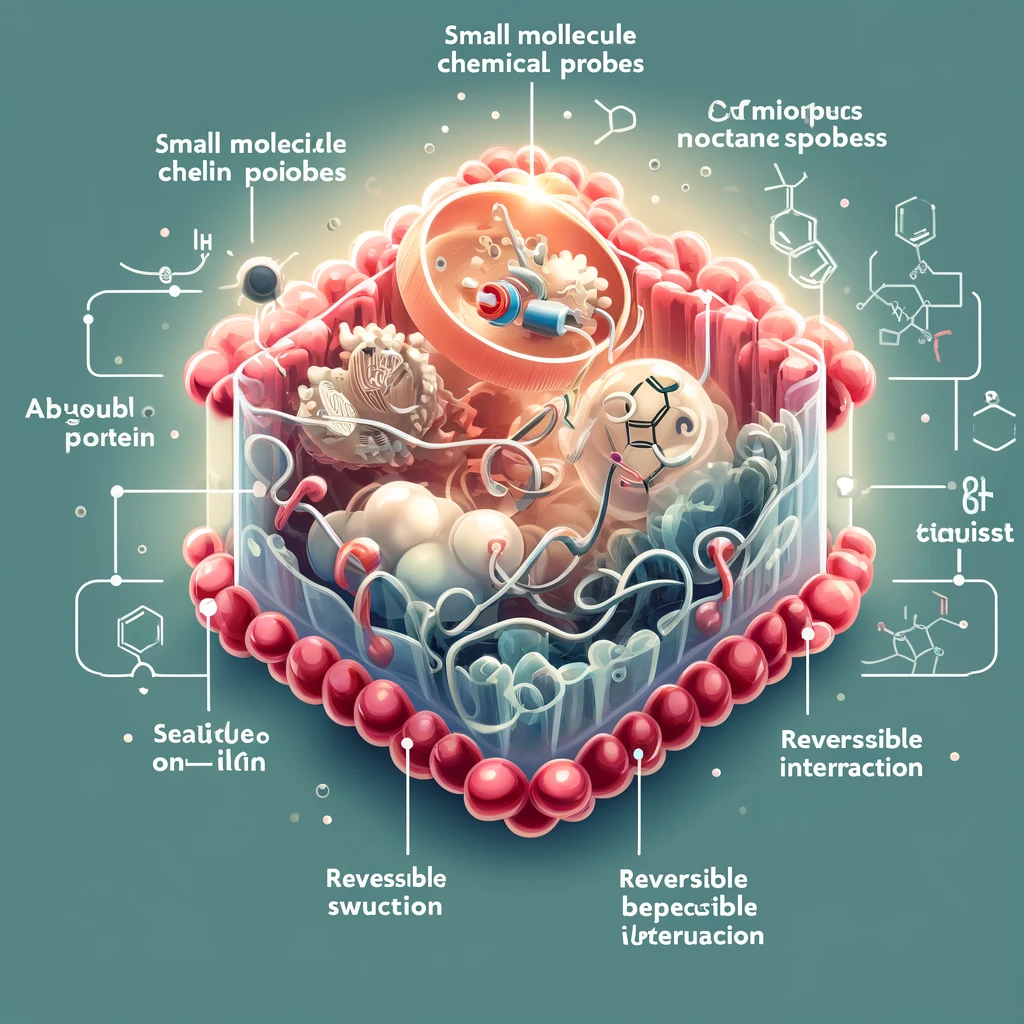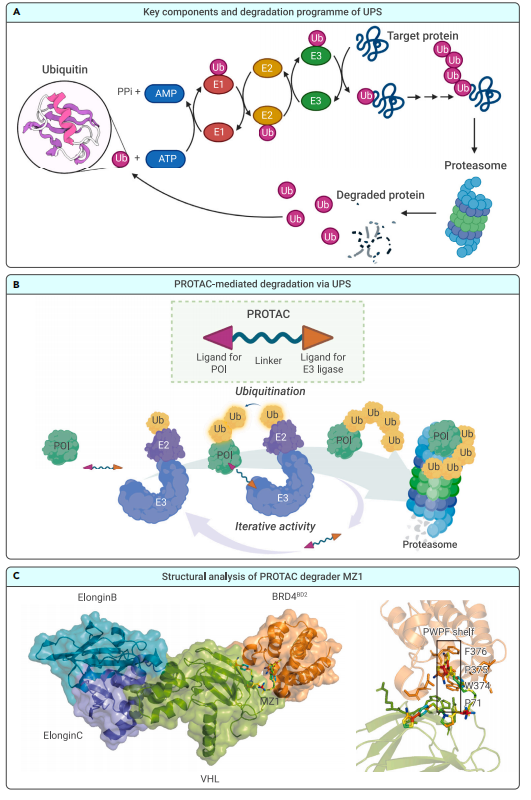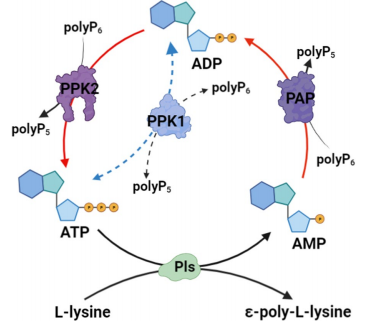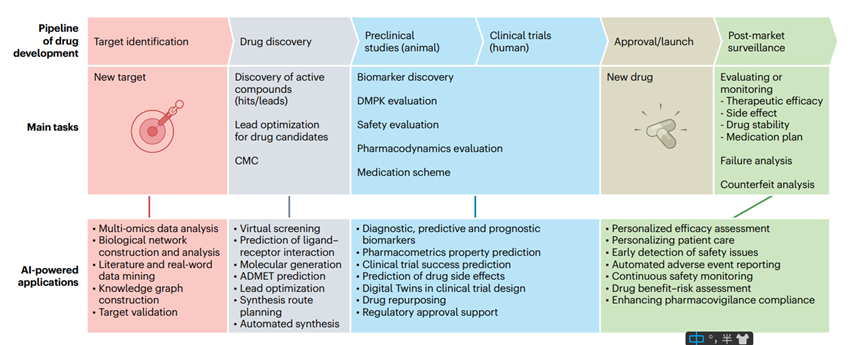Overview Introduction to IL-6
Abstract
Interleukin-6 (IL-6) is a key cytokine that regulates immune responses, inflammation, and tumor progression. As a glycoprotein in the “4α-helix” cytokine family, IL-6 is encoded on chromosome 7p21 and is upregulated during infection, cellular damage, or immune activation. IL-6 signaling involves the IL-6 receptor (IL-6R) and gp130, activating pathways like JAK/STAT3, MAPK/ERK, and PI3K/Akt to control cell proliferation, survival, and differentiation. IL-6 drives inflammatory diseases and allergic responses and fosters tumor growth, angiogenesis, and immune evasion. IL-6 inhibitors, including tocilizumab, show promise in reducing tumor progression and inflammation in clinical trials.
Structure and basic characteristics of IL-6
Structure of IL-6: IL-6 is a glycoprotein composed of a four-helix structure with about 184 amino acids, belonging to the “4α-helix” cytokine family. Cytokines in this family play a key role in regulating immune responses and inflammatory processes.
Gene and expression regulation: The IL-6 gene is located on human chromosome 7p21 and is usually transcribed and expressed when infected, damaged, or activated by immune signals. NF-kB and STAT3 are key transcription factors that regulate its gene expression and play a role in inflammation and stress.
Fig. 1 IL-6 synthesis, mRNA regulation
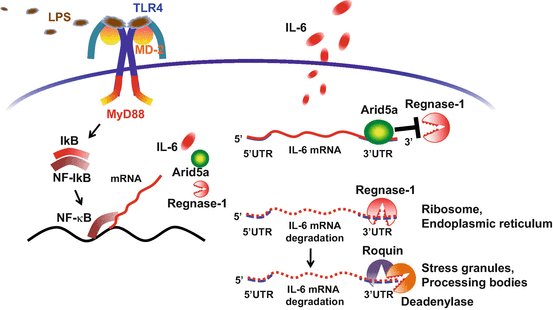
Fig. 2 IL-6 Biologie
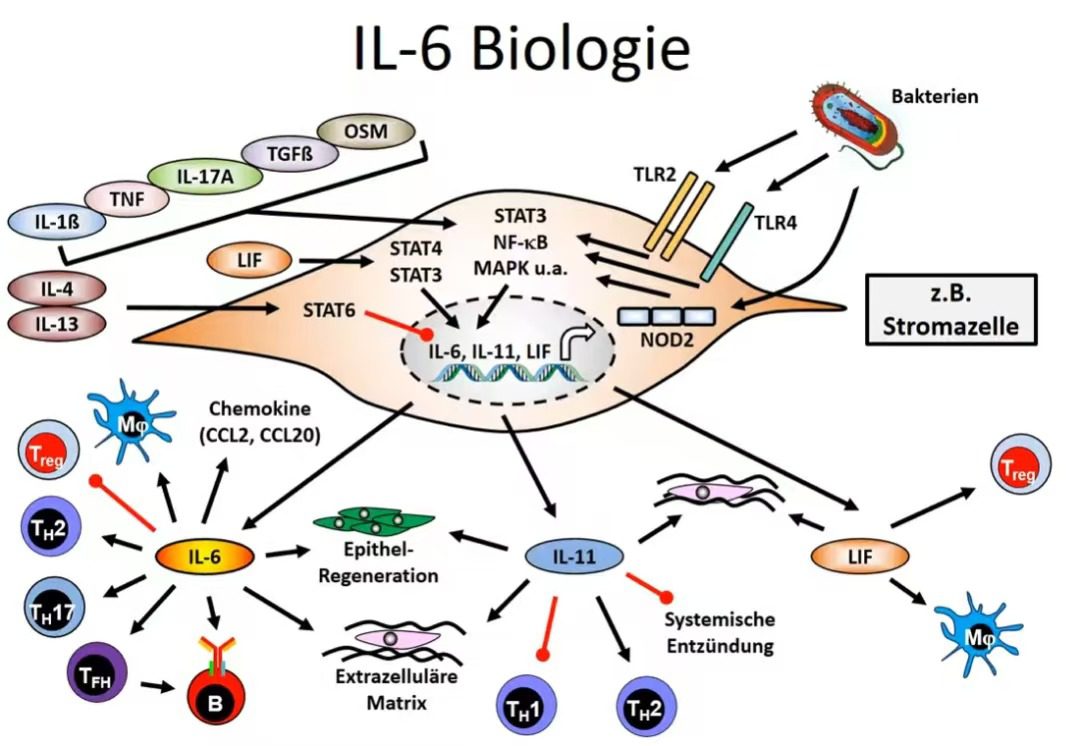
Fig. 3 IL-6: Zielzellen und -organe
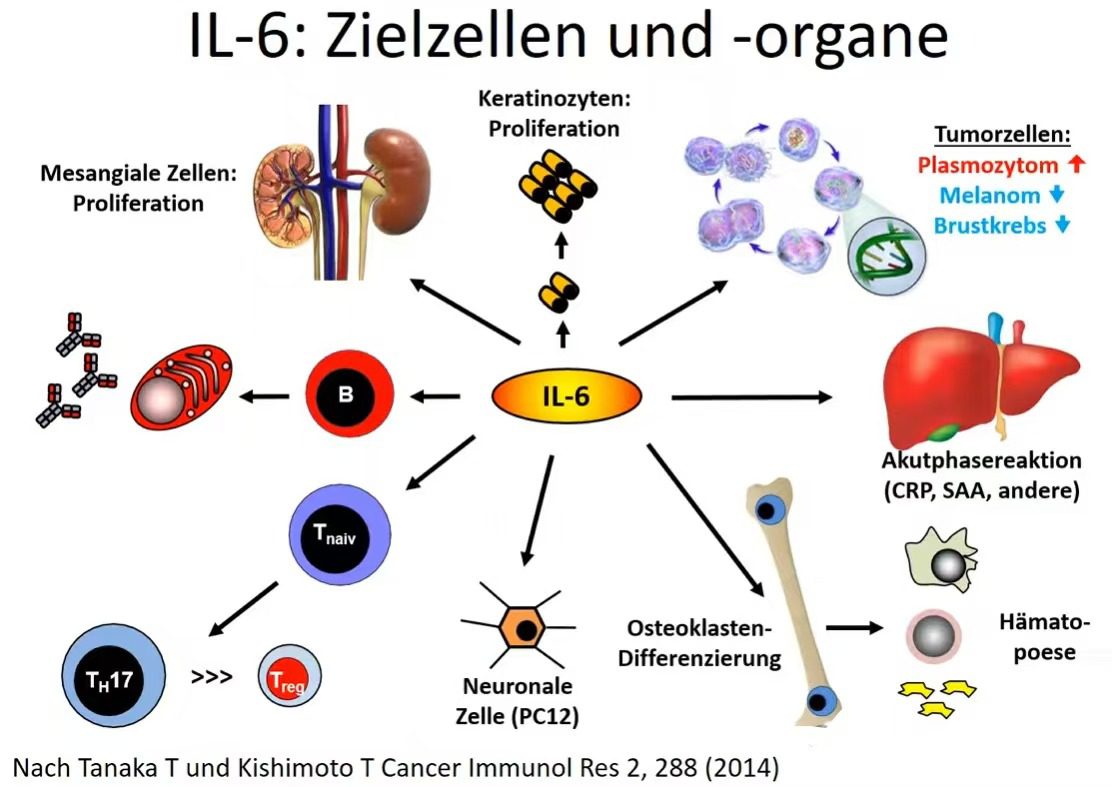
Fig.4 IL-6 Rezeptor und Signaling
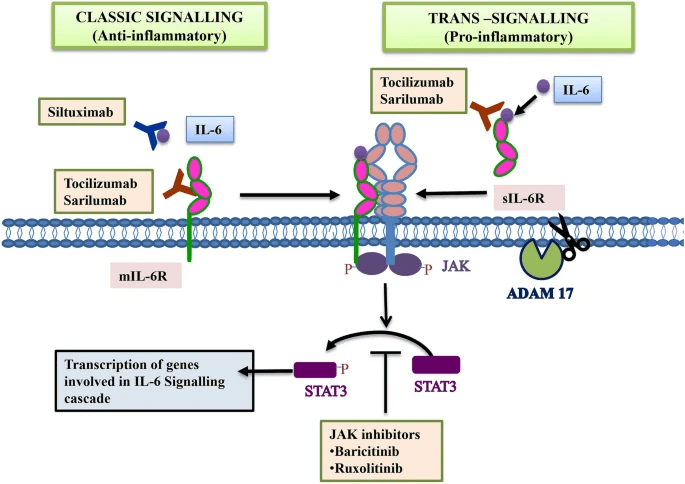
IL-6 signal transduction mechanism
The signal transduction mechanism of IL-6 involves its binding to the receptor (IL-6R) and the co-receptor gp130. IL-6 activates intracellular signaling pathways through various pathways such as classical signal transduction, trans-signaling, and trans-presentation to achieve regulation of cell function.
1. Classical signal transduction
Process: In classical signal transduction, IL-6 first binds to the membrane-bound IL-6R, then forms an IL-6/IL-6R complex, and then binds to gp130 to form a signal transduction complex. This complex recruits and activates Janus kinase (JAK) through gp130, which then phosphorylates and activates STAT3. STAT signal transduction and activation: The activated STAT3 transcription factor enters the cell nucleus, induces the transcription of IL-6 target genes, and promotes biological functions such as cell proliferation, differentiation, and anti-apoptosis. Classical signals mainly play a role in cells expressing membrane-bound IL-6R, such as hepatocytes, monocytes, and certain T cells.
2. Trans-signaling
Features: Trans-signaling is achieved through soluble IL-6R (sIL-6R). sIL-6R is produced by protease cleavage of membrane-bound IL-6R and can still transmit IL-6 signals in cells that do not express membrane-bound IL-6R (such as endothelial cells and fibroblasts).
Mechanism of action: After IL-6 binds to sIL-6R, it interacts with gp130 and activates the downstream JAK/STAT signaling pathway. Trans-signaling is dominant in many inflammatory and immune diseases and can widely affect various cell types in tissues.
3. Trans-presentation
Process: Trans-presentation is a mechanism for transmitting signals through membrane-bound IL-6R expressed by antigen presenting cells (APCs). IL-6 first binds to membrane-bound IL-6R on APCs and then transmits signals to adjacent cells (such as T cells) through gp130.
Clinical significance: This mechanism plays an important role in regulating specific T cell subsets (such as TH17 cells) and may play a role in certain autoimmune diseases and chronic inflammation.
4. Intracellular signaling
Some studies have shown that IL-6 receptors can also be located in cells under certain circumstances and regulate cell responses through intracellular signaling pathways. However, this mechanism is less common and its biological function has not yet been fully clarified.
Downstream effects of IL-6 signaling pathway and its biological mechanism
1. JAK/STAT3 pathway
Activation process: IL-6 activates JAK1 and JAK2 through gp130, and JAK kinase transfers phosphate groups to STAT3 protein, causing it to dimerize and translocate to the nucleus.
Downstream target genes: STAT3 activation causes the expression of multiple target genes, such as Bcl-2 (anti-apoptotic protein), Cyclin D1 (cell cycle regulatory protein), etc. The expression of these genes can promote cell proliferation and enhance survival ability.
Clinical association: Abnormal activation of JAK/STAT3 is closely related to a variety of diseases (such as tumors, autoimmune diseases, chronic inflammation, etc.), so JAK inhibitors have become new targets for the treatment of some diseases.
2. MAPK/ERK pathway
Signal transmission: IL-6 activates the MAPK cascade through gp130, thereby starting the ERK1/2 signaling pathway. After ERK enters the nucleus, it promotes gene expression and cell proliferation.
Biological effects: The MAPK/ERK signaling pathway plays an important role in cell proliferation, differentiation and inflammatory response. This pathway plays a key regulatory role in the proliferation and migration of tumor cells, so its abnormal activation may promote the malignant transformation of tumors.
3. PI3K/Akt pathway
Activation process: IL-6 signal activates Akt (also known as protein kinase B) through PI3K, and this process depends on the synergistic effect of gp130 and JAK.
Downstream effect: Akt activation can promote cell survival, inhibit apoptosis, and support cell metabolic needs. The PI3K/Akt signaling pathway plays a key role in the anti-apoptosis process.
Role in tumors: The PI3K/Akt pathway is abnormally activated in many tumors, prompting tumor cells to evade apoptosis and enhance resistance to chemotherapy. Therefore, PI3K inhibitors have certain potential application value in tumor treatment.
The role of IL-6 in the immune system and allergic reactions
IL-6 is a pro-inflammatory factor that plays a central role in acute and chronic inflammation. It significantly regulates immune responses by affecting the differentiation and function of immune cells such as T cells and B cells, especially in allergic diseases.
Control of allergic reactions:
IL-6 promotes the body’s response to exogenous allergens by stimulating the differentiation of TH2 cells and TH17 cells.
In diseases such as allergic asthma, IL-6 levels are significantly elevated, and IL-6 can further activate the STAT3 signaling pathway through its receptors and promote IgE-mediated allergic reactions.
Studies have shown that IL-6 can directly participate in the occurrence of immediate allergic reactions by affecting the activation of mast cells and eosinophils. In addition, in chronic allergic reactions, IL-6 can also promote the maintenance of a chronic inflammatory environment and the formation of fibrosis.
Inhibition of regulatory T cells: IL-6 has an inhibitory effect on regulatory T cells (Treg), thereby weakening the immune system’s self-tolerance ability, which may lead to increased reactivity in some allergic diseases.

Fig. 5 Protumour and antitumour actions of IL-6 in the tumour microenvironment (TME).
Relationship between IL-6 and tumor development
IL-6 plays an important role in the occurrence, development and immune escape of tumors. It can promote tumor growth by promoting cell proliferation and inhibiting cell apoptosis, and can also inhibit the proliferation of tumor cells in some cases.
1. Proliferation and anti-apoptosis effects in tumors
Promoting tumor proliferation: IL-6 is highly expressed in many tumors (such as liver cancer, breast cancer, ovarian cancer, etc.), and its signaling pathway mainly activates STAT3 through the classical pathway (IL-6R/gp130 complex), thereby upregulating anti-apoptotic and pro-proliferation genes such as Bcl-2 and Cyclin D1.
Angiogenesis and microenvironment regulation: IL-6 can promote the formation of tumor angiogenesis by inducing the expression of vascular endothelial growth factor (VEGF), improve the oxygen supply and nutrition of the tumor microenvironment, and thus provide a suitable growth environment for tumor cells.
Cell metastasis: IL-6 promotes the metastasis and invasiveness of tumor cells by changing their adhesion. This has been experimentally proven in many tumors such as breast cancer and prostate cancer.
2. IL-6 and tumor immune escape
Immunosuppressive microenvironment: IL-6 induces the secretion of inhibitory cytokines (such as IL-10) by activating the STAT3 and STAT1 signaling pathways, thereby forming an immunosuppressive state in the tumor microenvironment and inhibiting anti-tumor immune responses.
Inhibition of immune cell activity: IL-6 not only inhibits the activity of T cells and NK cells, but also upregulates the function of regulatory T cells (Treg), further promoting tumor immune escape.
Affecting antibody production: In B cells, IL-6 can induce them to differentiate into plasma cells and increase antibody secretion, but such antibodies often do not have effective anti-tumor activity, so their effect on tumor defense is limited.
3. Clinical relevance: IL-6 inhibitors in tumor treatment
Based on the tumor-promoting effect of IL-6, a variety of IL-6 inhibitors (such as tocilizumab) are currently used in clinical trials to block the IL-6 signaling pathway to curb tumor growth.
Studies have shown that IL-6 blocking therapy has shown good efficacy in some tumor types (such as multiple myeloma), reducing the proliferation and angiogenesis of tumor cells by reducing the levels of inflammatory factors and VEGF.
References
- Kishimoto, T. (2010). IL-6: from its discovery to clinical applications. International Immunology, 22(5), 347-352.
- Hunter, C. A., & Jones, S. A. (2015). IL-6 as a keystone cytokine in health and disease. Nature Immunology, 16(5), 448-457.
- Rose-John, S. (2012). IL-6 trans-signaling via the soluble IL-6 receptor: importance for the pro-inflammatory activities of IL-6. International Journal of Biological Sciences, 8(9), 1237-1247.
- Tanaka, T., Narazaki, M., & Kishimoto, T. (2014). IL-6 in inflammation, immunity, and disease. Cold Spring Harbor Perspectives in Biology, 6(10), a016295.
- Jones, S. A., Scheller, J., & Rose-John, S. (2011). Therapeutic strategies for the clinical blockade of IL-6/gp130 signaling. Journal of Clinical Investigation, 121(9), 3375-3383.
- Wang, X., et al. (2019). IL-6 promotes T cell proliferation and differentiation through the STAT3 pathway in rheumatoid arthritis. Rheumatology, 58(2), 300-310.
- Heinrich, P. C., et al. (2003). Principles of interleukin (IL)-6-type cytokine signalling and its regulation. Biochemical Journal, 374(1), 1-20.
- Ghosh, S., & Karin, M. (2002). Missing pieces in the NF-kappaB puzzle. Cell, 109(Suppl), S81-S96.
- Scheller, J., & Rose-John, S. (2006). Interleukin-6 and its receptor: from bench to bedside. Medical Microbiology and Immunology, 195(4), 173-183.
- Grivennikov, S. I., Greten, F. R., & Karin, M. (2010). Immunity, inflammation, and cancer. Cell, 140(6), 883-899.
- Mihara, M., et al. (2012). IL-6/IL-6 receptor system and its role in physiological and pathological conditions. Clinical Science, 122(4), 143-159.
- Jostock, T., et al. (2001). Soluble gp130 is the natural inhibitor of soluble IL-6 receptor transsignaling responses. European Journal of Biochemistry, 268(1), 160-167.

